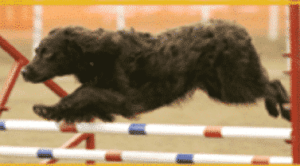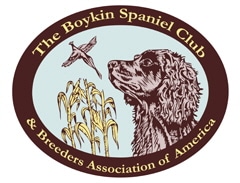The joy of owning a Boykin Spaniel is strongest when both dog and owner work together to achieve a common goal. The breed’s versatility is demonstrated by its participation in many activities, including hunt tests, working ability certification, conformation, rally, dock diving, scent work, obedience, and therapy work. This discussion will be on an activity that is enjoyable for both Boykin and handler alike—agility.
Boykin Spaniels are ideal agility dogs. They are quick-thinking, resourceful, athletic, and eager-to-please. These innate characteristics of the breed are the key to success in the agility ring.
 The goal of agility is to navigate an obstacle course without error, as quickly as possible. A typical course consists of 13-20 obstacles, including jumps, weave poles, tunnels, and contact obstacles (the “dog walk,” A-frame, and see-saw). The height of the jumps depends on the dog’s height at the withers; most Boykin Spaniels will jump 16 inches.
The goal of agility is to navigate an obstacle course without error, as quickly as possible. A typical course consists of 13-20 obstacles, including jumps, weave poles, tunnels, and contact obstacles (the “dog walk,” A-frame, and see-saw). The height of the jumps depends on the dog’s height at the withers; most Boykin Spaniels will jump 16 inches.
Dogs earn points toward agility titles by successfully navigating the course within a specified time limit. There are several categories of agility competition, each with its own series of AKC titles. A good choice for beginners is Jumpers with Weaves (JWW) because the course consists only of jumps, tunnels, and weave poles. In Standard agility, the course contains every type of obstacle. In each category, competition progresses through four difficulty levels; Novice, Open, Excellent, and Masters. As the level increases, the courses get more complicated, have more obstacles, allow fewer faults, and require faster completion times.
To get started in agility with your Boykin Spaniel, it is necessary to find an experienced mentor. Ideally, a mentor should have successfully competed in agility at the Excellent or Masters (formerly “Excellent B”) level with more than one dog. Your mentor will offer advice and support, and help you find training courses, agility equipment to borrow or purchase, and competitions to enter. Typically, training courses are offered by local dog training clubs or pet-oriented businesses. Beginner-level courses focus on teaching your dog individual obstacles, and upper-level courses focus on sequencing multiple obstacles and preparing
for competition.
 The following practical advice is offered from previous experiences in agility. Teach your dog the weave poles first and practice them often. Also, the see-saw will require a considerable amount of practice before you proceed from JWW to Standard courses. These two obstacles are the most difficult to learn. Once mastered, however, your dog will be on its way to a successful agility career.
The following practical advice is offered from previous experiences in agility. Teach your dog the weave poles first and practice them often. Also, the see-saw will require a considerable amount of practice before you proceed from JWW to Standard courses. These two obstacles are the most difficult to learn. Once mastered, however, your dog will be on its way to a successful agility career.
Importantly, there are non-competitive options for participation in agility. This allows dogs and handlers/owners to benefit from the exercise, teamwork, and fun of agility without the pressure, travel, and expense of competition. The non-competitive approach is also helpful for deciding whether agility is a good fit for you and your dog. Your mentor will know about opportunities in your area and will be able to point you to websites where you can find local agility resources.
The Boykin Spaniel is an agile breed. They are quick, alert, eager-to-please, and will succeed at anything they are asked to do. An excellent outlet for your Boykin’s talent may be to participate in agility. Whatever you choose to do with your Boykin Spaniel, remember that the most rewarding aspect of owning a Boykin Spaniel is the sense of accomplishment and pride that comes with participating in an activity that you both enjoy.
by Jeff Engelmann,
Boykin Spaniel Club and
Breeders Association of America
A version of this article originally appeared in the July 2013 issue of the AKC Gazette.



 The goal of agility is to navigate an obstacle course without error, as quickly as possible. A typical course consists of 13-20 obstacles, including jumps, weave poles, tunnels, and contact obstacles (the “dog walk,” A-frame, and see-saw). The height of the jumps depends on the dog’s height at the withers; most Boykin Spaniels will jump 16 inches.
The goal of agility is to navigate an obstacle course without error, as quickly as possible. A typical course consists of 13-20 obstacles, including jumps, weave poles, tunnels, and contact obstacles (the “dog walk,” A-frame, and see-saw). The height of the jumps depends on the dog’s height at the withers; most Boykin Spaniels will jump 16 inches. The following practical advice is offered from previous experiences in agility. Teach your dog the weave poles first and practice them often. Also, the see-saw will require a considerable amount of practice before you proceed from JWW to Standard courses. These two obstacles are the most difficult to learn. Once mastered, however, your dog will be on its way to a successful agility career.
The following practical advice is offered from previous experiences in agility. Teach your dog the weave poles first and practice them often. Also, the see-saw will require a considerable amount of practice before you proceed from JWW to Standard courses. These two obstacles are the most difficult to learn. Once mastered, however, your dog will be on its way to a successful agility career.





